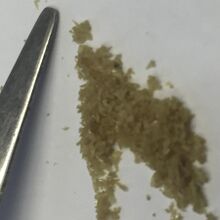Chemistry:(Norbornadiene)molybdenum tetracarbonyl
From HandWiki

| |

| |
| Identifiers | |
|---|---|
3D model (JSmol)
|
|
| ChemSpider | |
PubChem CID
|
|
CompTox Dashboard (EPA)
|
|
| |
| |
| Properties | |
| C11H8MoO4 | |
| Molar mass | 300.13 g·mol−1 |
| Hazards | |
| GHS pictograms | 
|
| GHS Signal word | Warning |
| H302, H312, H315, H319, H332, H335 | |
| P261, P264, P270, P271, P280, P301+312, P302+352, P304+312, P304+340, P305+351+338, P312, P321, P322, P330, P332+313, P337+313, P362, P363, P403+233, P405, P501 | |
Except where otherwise noted, data are given for materials in their standard state (at 25 °C [77 °F], 100 kPa). | |
| Infobox references | |
(Norbornadiene)molybdenum tetracarbonyl is the organomolybdenum compound with the formula (C7H9)Mo(CO)4. Structurally, the compound consists of the norbornadiene bonded to a Mo(CO)4 fragment. The compound is a yellow, volatile solid. It is prepared by thermal or photochemical substitution of molybdenum hexacarbonyl.[1] The compound was originally examined as a potential antiknock agent.[2]
(Norbornadiene)molybdenum tetracarbonyl is a precursor to other derivatives of the type L2Mo(CO)4. This conversion exploits the lability of the diene ligand:[3]
- (C7H9)Mo(CO)4 + 2 L → C7H9 + L2Mo(CO)4
References
- ↑ Werner, Helmut; Prinz, Richard (1967). "Ein neuer Weg zur Darstellung substituierter Metallcarbonyl-Komplexe von Chrom und Molybdän". Chemische Berichte 100: 265–270. doi:10.1002/cber.19671000131.
- ↑ Ihrman, Kryn G.; Coffield, Thomas H., "Cyclic diene metal carbonyl complexes", US patent 3093671, published 1963-06-11
- ↑ Hahn, F. Ekkehardt; Wittenbecher, Lars; Le Van, Duc; Fröhlich, Roland (2000). "Evidence for an Equilibrium between an N-Heterocyclic Carbene and Its Dimer in Solution". Angewandte Chemie International Edition 39 (3): 541–544. doi:10.1002/(SICI)1521-3773(20000204)39:3<541::AID-ANIE541>3.0.CO;2-B. PMID 10671250.
External links
 |

